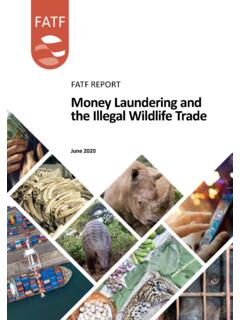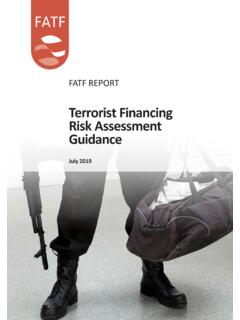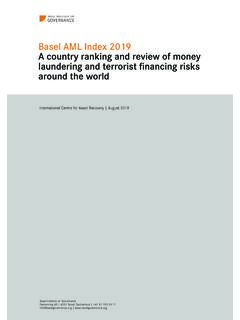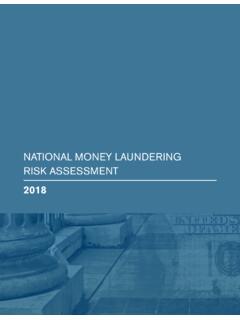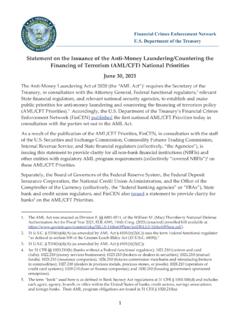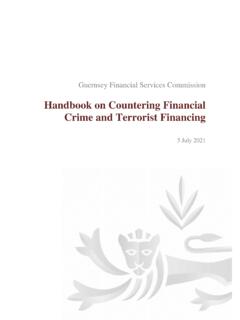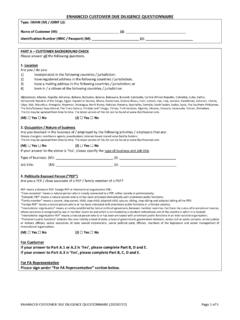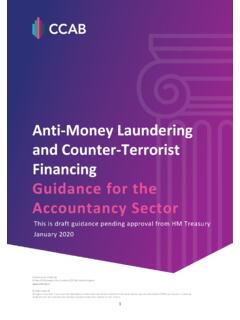Transcription of Anti-Money Laundering Act of 2020 - Sullivan & Cromwell
1 New York Washington, Los Angeles Palo Alto London Paris Frankfurt Brussels Tokyo Hong Kong Beijing Melbourne Sydney December 17, 2020 Anti-Money Laundering Act of 2020 New Legislation to Implement Comprehensive Modernization and Reform of the US AML/CFT Regime SUMMARY On December 11, 2020, the Senate passed the Anti-Money Laundering Act of 2020 ( AMLA or the Act ) DIVISION F of the National Defense Authorization Act for fiscal year 2021 (the NDAA ). The House of Representatives had previously passed the measure on December 8, 2020. The NDAA was promptly enrolled and sent to the President. President Trump has publicly indicated that he intends to veto the bill for reasons unrelated to the Act, and the White House has issued a Statement of Administration Policy explaining that the President s advisors would recommend a veto.
2 If the legislation is vetoed by the President, Congress may seek to override the veto. The measure was passed in both chambers by margins that exceed those required to override a Presidential veto. This memorandum provides an overview of the key themes and significant provisions in the Act. We plan to issue additional memoranda in the near future addressing in greater depth and detail various aspects of the legislation. Although the Bank Secrecy Act ( BSA ) has been amended numerous times since its enactment in 1970, including the significant changes made by the USA PATRIOT Act following the September 11th terrorist attacks, as the Joint Explanatory Statement accompanying the Act states, the Anti-Money Laundering regime has not seen such comprehensive reform and modernization since the BSA s The wide-ranging legislation includes numerous substantive provisions aimed at modernizing and addressing perceived gaps in the country s approach to Anti-Money Laundering /countering the financing of terrorism ( AML/CFT ), including the absence of corporate beneficial ownership reporting requirements at the national level.
3 -2- Anti-Money Laundering Act of 2020 December 17, 2020 The Act represents the culmination of multi-year efforts to reform the BSA regime by addressing longstanding concerns voiced by the private and public sectors. The Act draws from several prior legislative attempts to reform various specific aspects of the BSA including the Corporate Transparency Act of 2019, the Illicit CASH Act of 2020 and the STIFLE Act of 2020. And it responds to a diverse coalition of stakeholders who have advocated for changes to the BSA regime by addressing a range of concerns regarding the need for increased corporate transparency and an end to anonymous shell companies, increased information-sharing, the use of feedback to improve the effectiveness of AML/CFT programs, and reinforcing FinCEN s role as the country s principal BSA/AML authority.
4 These concerns, and to a large extent the Act s mechanisms to address them, have been identified and discussed in various BSA-focused fora over the years, with input and substantial participation from not only financial institutions and their regulators, but also law enforcement and public policy experts. Although much of the Act s effectiveness hinges on implementation through various regulations, reports and assessments, it represents one of the most significant milestones to date in Congressional efforts to modernize and reform the BSA. This memorandum provides an overview of key aspects of the legislation, focusing on the following themes: Codification of the risk-based approach to AML/CFT compliance Modernization through technology and innovation, streamlining low-value processes, eliminating obsolete regulations and guidance, and broadening the BSA s reach to confront emerging money- Laundering threats Expanding enforcement- and investigation-related authority, including a significant expansion in the authority to subpoena foreign banks that maintain correspondent accounts with banks Beneficial ownership disclosure, including reporting requirements for certain corporations and limited liability companies Emphases on coordination, cooperation, and information-sharing among and between financial institutions.
5 Domestic financial regulators and foreign financial regulators2 Balancing financial inclusion and de-risking concerns with AML/CFT program effectiveness goals 1. CODIFICATION OF THE RISK-BASED APPROACH One of the Act s goals is to reinforce and codify a risk-based approach to AML/CFT. This goal is reflected in the Act s amendments to the enumerated purposes of the BSA to include: Requiring reports or records that are highly useful in assessing risks; Preventing money Laundering and the financing of terrorism through the establishment by financial institutions of reasonably designed risk-based programs ; and Assessing the money Laundering , terrorism finance, tax evasion and fraud risks to financial institutions to protect the financial system from -3- Anti-Money Laundering Act of 2020 December 17, 2020 Preventing money Laundering and the financing of terrorism through reasonably designed risk-based programs, in particular, marks a departure from the existing purpose of the BSA, which is to require reports and records where they have a high degree of usefulness to law enforcement, regulators, and national security Following are three additional examples of ways in which the Act reinforces and codifies the risk-based approach: National Priorities.
6 First, it requires Treasury5 to establish national priorities for AML/CFT and financial institutions to incorporate these priorities into their risk-based AML/CFT programs. Such incorporation will be a basis on which financial institutions are examined for BSA compliance. The legislation not only makes explicit the responsibility of financial institutions to ensure that their programs are risk-based and reflective of published Treasury priorities, but it also aims to ensure alignment in this respect with the federal functional regulators BSA-related supervision and examinations. AML/CFT Program Standards: Second, it requires Treasury and the federal functional regulators to use a risk-based approach to setting minimum standards for AML/CFT programs and examining for compliance with those standards.
7 Over the years, FinCEN and the functional regulators have moved towards a risk-based approach, primarily via guidance. The Act codifies that approach, with factors in prescribing, supervising and examining AML/CFT programs to include that they be (a) reasonably designed to assure and monitor compliance with the BSA and (b) risk-based, including ensuring that more attention and resources of financial institutions are directed toward higher-risk customers and activities, consistent with the financial institution s risk profile. The Act provides that the duty to establish, maintain and enforce an AML/CFT program must remain the responsibility of, and be performed by, persons in the United States, which could impact institutions that conduct certain elements of financial crimes compliance Factors in Requiring Suspicious Activity Reports: Third, it requires Treasury to consider the purposes of the BSA, as amended, as well as national priorities, when requiring financial institutions to file suspicious activity reports ( SARs ).
8 7 SARs must be guided by a financial institution s BSA program, including risk assessment processes that take into account the national Although the reinforcement and codification of the risk-based approach are welcome, the Act does not appear to require conforming or aligning amendments to be made to the federal functional regulators AML/CFT-related rules, including those requiring AML/CFT programs and SARs. Those rules generally were issued under authorities other than the BSA and, although in many respects they are consistent with FinCEN s rules, there are notable differences and, in some instances, non-BSA-related purposes that are also Accordingly, one issue that Treasury will likely consider, consistent with the Act s various references to minimizing or reducing burden, is whether any new AML/CFT program and SAR rules increase the burden on financial institutions by adding to obligations imposed by the federal functional regulators 2.
9 MODERNIZATION OF THE AML/CFT REGIME Another theme of the Act is the modernization of the AML/CFT regime, with emphases on embracing technology and innovation, streamlining low-value processes, and eliminating obsolete regulations and -4- Anti-Money Laundering Act of 2020 December 17, 2020 The legislation seeks to accomplish this objective in several ways including, among others: requirements that an Innovation Officer be appointed at FinCEN and each federal functional regulator; the establishment of a Bank Secrecy Act Advisory Group subcommittee on innovation and technology; a mandatory financial technology assessment by Treasury and a requirement that FinCEN maintain emerging technology experts. However, in our view, the most significant changes will likely come through several mandatory review, rule-writing and revision requirements.
10 We believe the following five such requirements are particularly noteworthy:12 Technology Testing Rulemaking: Treasury must issue a rule that specifies the standards for testing the technology and internal processes that are used to comply with the BSA, such as transaction monitoring The standards are intended to allow for innovation, such as the use of machine learning, with risk-based approaches to the testing and risk management of these innovative methods. The Federal Financial Institutions Examination Council (the FFIEC ) will be required to update its manuals to reflect Treasury s rule and to be consistent with relevant FinCEN and federal functional regulator guidance, including the 2018 Joint Statement on Innovative Efforts to Combat Money Laundering and Terrorist Streamlined Noncomplex SAR Filings: Mandatory considerations for Treasury, when imposing suspicious activity reporting requirements will include requiring that FinCEN establish streamlined (automated) processes for filing noncomplex categories of Formal Review of CTR and SAR Requirements.










